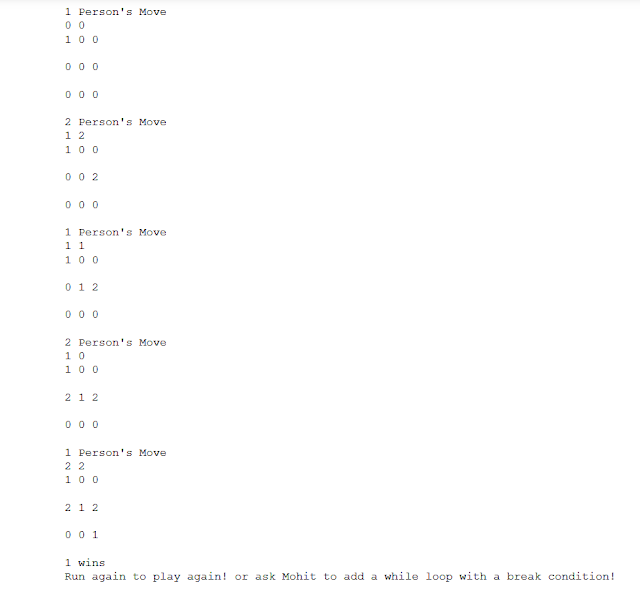Snackdown 2019 Problem Teammate
Hii everyone!
Me and my friend Deepankar Sharma got Rank 1 in the Qualifier round of Snackdown 2019 and here is the question I liked the most.The math behind this problem was solved by me and Rishabh Verma and the code was figured out by me and Deepankar Sharma.I'll keep it simple just the question as it is from codechef and the solutions in terms of Math/logic and followed by the code in Python.Please try atleast once to solve it yourself then only you will understand the beauty of this question.To fork peep into my github account www.github.com/fivecube.
So here's the question...
So what comes to mind at a first glance is what if we just sort the skill index and then start making tuples of 2. Like if we have
3,8,4,1,9,6,2,5,7,14
skill indexes of 10 people then sorted will be
1,2,3,4,5,6,7,8,9,14
and thus the valid pairs are clearly one which is
(1,2),(3,4),(5,6),(7,8),(9,14)
So ans is 1 in this case.
You can see the same result with permutation as 2 can form pairs with 3 different one so ans is 3.
So the 5*3*1=15 pairs would be
It is awesome that this logic can be applied to more odd cases similarly.
So the ans is 2*(1)=1
You can understand the same with Permutation and combinations as well.If we stick one 1 to a tuple than it can make pair with 3 other 1.Hence 3*1=3Me and my friend Deepankar Sharma got Rank 1 in the Qualifier round of Snackdown 2019 and here is the question I liked the most.The math behind this problem was solved by me and Rishabh Verma and the code was figured out by me and Deepankar Sharma.I'll keep it simple just the question as it is from codechef and the solutions in terms of Math/logic and followed by the code in Python.Please try atleast once to solve it yourself then only you will understand the beauty of this question.To fork peep into my github account www.github.com/fivecube.
So here's the question...
Math/logic
The answer will be different for Odd and Even repetitions.
Let's solve for odd first:Odd Case:
F=1
You might have figured out that the problem occurs when their are multiple people with same index score. If it would have only distinct Skill index then we would have said the answer is 1 in each case.So what comes to mind at a first glance is what if we just sort the skill index and then start making tuples of 2. Like if we have
3,8,4,1,9,6,2,5,7,14
skill indexes of 10 people then sorted will be
1,2,3,4,5,6,7,8,9,14
and thus the valid pairs are clearly one which is
(1,2),(3,4),(5,6),(7,8),(9,14)
So ans is 1 in this case.
F=3
Skill index list(sorted)-: 1,1,1,2,5,7,9,15
So the 3*1=3 pairs would be- (1,1),(1,2),(5,7),(9,15)
- (1,1),(1,2),(5,7),(9,15)
- (1,1),(1,2),(5,7),(9,15)
- (1,1),(1,2),(5,7),(9,15)
- (1,1),(1,2),(5,7),(9,15)
- (1,1),(1,2),(5,7),(9,15)
You can see the same result with permutation as 2 can form pairs with 3 different one so ans is 3.
F=5
Now what about skill index(sorted) -: 1,1,1,1,1,2,5,7,9,15So the 5*3*1=15 pairs would be
- (1,1),(1,1),(1,2),(5,7),(9,15)
- (1,1),(1,1),(1,2),(5,7),(9,15)
- (1,1),(1,1),(1,2),(5,7),(9,15)
- (1,1),(1,1),(1,2),(5,7),(9,15)
- (1,1),(1,1),(1,2),(5,7),(9,15)
- (1,1),(1,1),(1,2),(5,7),(9,15)
- (1,1),(1,1),(1,2),(5,7),(9,15)
- (1,1),(1,1),(1,2),(5,7),(9,15)
- (1,1),(1,1),(1,2),(5,7),(9,15)
- (1,1),(1,1),(1,2),(5,7),(9,15)
- (1,1),(1,1),(1,2),(5,7),(9,15)
- (1,1),(1,1),(1,2),(5,7),(9,15)
- (1,1),(1,1),(1,2),(5,7),(9,15)
- (1,1),(1,1),(1,2),(5,7),(9,15)
- (1,1),(1,1),(1,2),(5,7),(9,15)
It is awesome that this logic can be applied to more odd cases similarly.
Generalized Result for odd times(n) repeated index
n*(n-2)*(n-4)*........ ..... .... . . . *1
Even Case:
F=2
Skill index list(sorted)-: 1,1,2,3,4,5,6,9
So there would be only 1 pair that is
- (1,1),(2,3),(4,5),(6,9)
- (0,1),(1,2),(3,4),(5,6)
- (0,1),(1,2),(3,4),(5,6)
So the ans is 2*(1)=1
F=4
Skill index list(sorted)-: 1,1,1,1,2,3,4,5,6,9
So there would be only 3 pairs-:
- (1,1),(1,1),(2,3),(4,5),(6,9)
- (1,1),(1,1),(2,3),(4,5),(6,9)
- (1,1),(1,1),(2,3),(4,5),(6,9)
But what if the skill index lis(sorted) is -: 0,1,1,1,1,2,3,4,5,6
So there would be 12 pairs-:
- (0,1),(1,1),(1,2),(3,4),(5,6)
- (0,1),(1,1),(1,2),(3,4),(5,6)
- (0,1),(1,1),(1,2),(3,4),(5,6)
- (0,1),(1,1),(1,2),(3,4),(5,6)
- (0,1),(1,1),(1,2),(3,4),(5,6)
- (0,1),(1,1),(1,2),(3,4),(5,6)
- (0,1),(1,1),(1,2),(3,4),(5,6)
- (0,1),(1,1),(1,2),(3,4),(5,6)
- (0,1),(1,1),(1,2),(3,4),(5,6)
- (0,1),(1,1),(1,2),(3,4),(5,6)
- (0,1),(1,1),(1,2),(3,4),(5,6)
- (0,1),(1,1),(1,2),(3,4),(5,6)
Clearly from permutation and combination point of view, we can see that similar results will appear.
Generalized result for Even times(m) repeated index
(m-1)*(m-3)*(m-5).... .. . . . . *1 (if they appear in m/2 tuples only)
m*(m-1)*(m-3)*(m-5).... .. .. . . . *1 (if they appear in more than m/2 tuples)
Bonus part
Q: How can we know this information of appearance of Even times repeated index is in m/2 tuples or more?
A: We can know the position of the first/last repeated element in the sorted index list and then we can conclude that if it appears in m/2 or more tuples based on if it is even or odd. See how...
For F=4
1,1,1,1,2,3,4,5,6,9
Position of last 1 is 4(even) (In python it is 3(odd))
But in 0,1,1,1,1,2,3,4,5,6
Position of last 1 is 5 (odd) (In python it is 4(even))
Thank You So Much!!!
Here's the code : Click here to go to my github repo.
from collections import Counter
foo = {1: 1, 2: 1, 3: 3, 4: 3}
last = 3
MOD = 10**9 + 7
for x in range(5, 10**5, 2):
p = (x*last) % MOD
foo[x] = p
foo[x+1] = p
last = p
for t in range(int(input())):
n = int(input())
a = list(map(int, input().split()))
a.sort()
c = Counter(a)
inds = {e: i for i, e in enumerate(a)}
ans = 1
for e, f in c.items():
ans *= foo[f]
if f % 2 == 0 and inds[e] % 2 == 0:
ans *= f
if ans > MOD:
ans = ans % MOD
print(ans % MOD)




Comments
Post a Comment